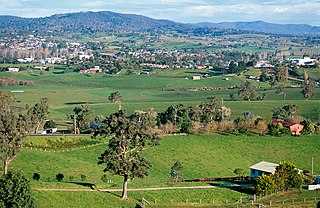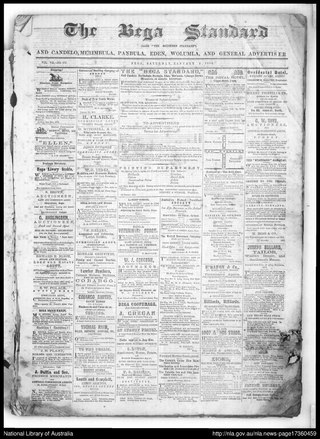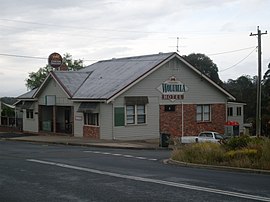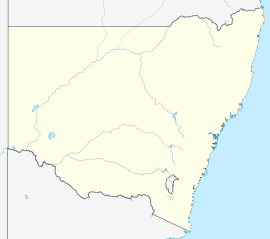
Gulaga National Park is a national park on the south coast of New South Wales, Australia, about 15 kilometres (9.3 mi) south of Narooma. The park is dominated by Gulaga, also known as Mount Gulaga. The former Wallaga Lake National Park, Goura Nature Reserve, and Mount Dromedary Flora Reserve were combined to form this park in 2001. The park features the southernmost subtropical rainforest in New South Wales.

Tweed Heads is a coastal city at the mouth of the Tweed River in the Northern Rivers region of the state of New South Wales, Australia. Tweed Heads is the northernmost town in New South Wales, and is located in the Tweed Shire local government area. It is situated 830 km (520 mi) north of Sydney and 103 km (64 mi) south of Brisbane. The town is next to the border with Queensland and is adjacent to its "twin town" of Coolangatta, which is a suburb of the Gold Coast in Queensland.

The Bega Valley Shire is a local government area located adjacent to the south-eastern coastline of New South Wales, Australia. The Shire was formed in 1981 with the amalgamation of the Municipality of Bega, Imlay Shire and Mumbulla Shire, with its name deriving from the town of Bega. The shire is also known as the Sapphire Coast for tourism and marketing purposes. During the 2019–20 Australian bushfire season, the area was devastated by fire, with 448 houses being destroyed by fire and approximately 365,000 hectares burned, which is 58% of the Shire's total land mass.

Bega is a town in the south-east of New South Wales, Australia, in the Bega Valley Shire. It is the economic centre for the Bega Valley.
Pambula is a town in Bega Valley Shire on the far south coast of New South Wales, Australia 454 kilometres (282 mi) south of Sydney via the Princes Highway. At the 2016 census, Pambula had a population of 970 people.

Merimbula is a town on the Merimbula Lake, located on the Far South Coast or Sapphire Coast of New South Wales, Australia. At the 2016 census, the population was 3,544.
Group 16 is a rugby league competition on the south coast of New South Wales, run under the auspices of the Country Rugby League. The Group 16 district covers the area from Batemans Bay down the Sapphire Coast to Eden, and inland across the Southern Tablelands to the Snowy Mountains towns of Cooma and Jindabyne.

Merimbula Airport is an airport serving Merimbula, New South Wales, Australia. It is located 1 nautical mile south of Merimbula and is owned and operated by Bega Valley Shire Council.
2EC is a radio station broadcasting to the South Coast of New South Wales, Australia, specifically the local government areas of Eurobodalla and Bega Valley. It is owned by East Coast Radio Pty. Ltd, which is a subsidiary of ARN.
Country Cricket New South Wales is responsible for the development of cricket in regional New South Wales. It is under control of the governing body Cricket NSW.

The Southern Star was a bi-weekly English language newspaper published on Wednesday and Saturdays in Bega, New South Wales, Australia. It was previously published as The Bega Gazette and County of Auckland Advertiser, and The Bega Gazette and Eden District or Southern Coast Advertiser.
Merimbula-Pambula Rugby League Football Club is an Australian rugby league football club based in New South Wales formed in 1924. They conduct teams for both Juniors & Seniors competitions. They participate in the Group 16 Rugby League competition in the south-east corner of New South Wales.
Thomas Frederic De Courcy Browne was an Irish-born Australian politician and journalist.

The Jubilee Exhibition Building in Adelaide, South Australia, was built to celebrate the 50th anniversary of Queen Victoria's accession to the throne on 20 June 1837. The jubilees of her Coronation on 28 June 1838, and of the Proclamation of South Australia on 28 December 1836, were also invoked on occasion.

The Bega Standard and Candelo, Merimbula, Pambula, Eden, Wolumla, and General Advertiser, also previously published as Southern Standard, was a weekly, later semiweekly English language newspaper published in Bega, New South Wales, Australia.

Frederick Metters was an ironworker, founder of the South Australian company which became Metters Limited, of South Australia, Western Australia and New South Wales, known for domestic and industrial cooking ovens and other cooking equipment, and for windpumps. Two of his brothers earlier founded a similarly named company in Victoria known for domestic and industrial cooking ovens.

Alexander Imlay was a Scottish-born pioneer settler in southern New South Wales. Alexander and his brothers George (1794?-1846), and Peter (1797–1881) operated in the region as pastoralists, whalers and shipbuilders. A number of things in the area were named after them. These include Imlay Street, the main street in Eden, the Mount Imlay National Park and Imlay Shire.
George Imlay (1794–1846), together with his brothers Alexander (1794–1847) and Peter (1797–1881), was a Scottish-born pioneer settler in southern New South Wales. All three reached Australia as military surgeons serving on convict ships. They operated in the region as pastoralists, whalers and shipbuilders.
Imlay Shire was a local government area in the South Coast region of New South Wales, Australia.
The Tribune was a newspaper first published in Melbourne, Australia in 1900 for the Roman Catholic Church.














